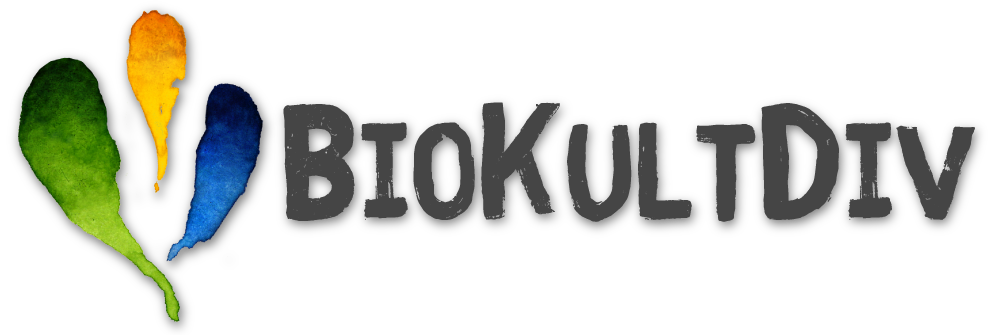In the last SES Global Conversation of this semester, the focus was on biocultural diversity. Jan Hanspach, Camila Benavides Frias and Stefan Ortiz Przychodzka led the session asking: What is biocultural diversity, and why should we care? The session began questioning what we associate with biocultural diversity, which largely focussed on foods, traditions, place-based practices, local knowledge and history.

From there on, Jan Hanspach explained the definitions of biocultural diversity, from broad to more narrow definitions that discuss the complexities and interdependency of cultural and biological diversity. He emphasised that biocultural diversity incorporates cultural practices, knowledge, worldviews and ontologies. Such knowledge and relationships affect language and vice versa, and Hanspach argued that humans are not separate from nature, they have a long history of interaction and co-evolution and this is reflected in our languages and cultures. Common threats exist to biological and cultural diversity, such as rapidly changing systems and globalisation, therefore the recognition of biocultural diversity is more significant now than ever. Recently aspects of biocultural diversity have been recognised in international governance, especially the importance of Indigenous Peoples and their protection of biodiversity, along with the significance of connections between nature and people for conservation.
Hanspach explained interrelations between biological, cultural, and linguistic diversity within complex socio-ecological adaptive systems and argued that although biocultural approaches are social-ecological, not all social-ecological approaches are biocultural. Biocultural diversity was often seen as dynamic, due to a more recent shifting of the focus from traditional systems with high stability and long histories, to transformed systems that also contain biocultural diversity, such as urban systems. There has also been a narrative shift in the literature from a crisis-oriented approach to biocultural diversity, to a more dynamic narrative.
Within the session, three main themes within biocultural diversity were discussed: cultural heritage; education; and biodiversity conservation. As Stefan Ortiz Przychodzka explained, cultural heritage referred to past, present and future legacies, such as traditions, knowledge and practices. This links to biocultural diversity through practices that relate to nature such as preservation, conservation and valorisation. We see examples of this in food, education, art, medicine, and landscapes. Camila Benavides Frias placed education in the context of biocultural diversity, and asked questions of how this affects what we teach, how we teach it and whether biocultural diversity can expand the way we think of education. Jan Hanspach linked biocultural diversity to old conservation methods, new conservation considerations, and proposals such as the Half-Earth approach. Within breakout rooms based on these three themes, open discussions were encouraged to link these concepts more closely to biocultural diversity.
Stefan Ortiz Przychodzka led the conversation on biocultural heritage and considered where heritage becomes biocultural rather than simply cultural, wherein participants highlighted living practices such as agriculture and land management. Local and traditional environmental knowledge was highlighted, such as generational practices, especially regarding food. Participants also argued that landscapes are not only managed but shaped by people, and altered through mobility such as migration, recipe sharing, and introduction of foreign species, and heritage could be both positively and negatively affected by these.
Camila Benavides Frias held a breakout session on education and biocultural diversity, by emphasising the ways in which knowledge may be shared more effectively by involving biocultural diversity and highlighting human-nature connections. Experimental ways of learning were discussed and learning beyond the classroom in order to embed practices in present memory. The concept of biocultural patrimony was discussed, through the reintroduction of old seeds in farming practices, and in the way biocultural diversity is reproduced in our culture in the future. Benavides Frias maintained that by doing and using our senses and connection with nature in teaching and learning, less formal education practices could be encouraged. By implementing biocultural education, even students in urban contexts could learn about biocultural diversity.
Jan Hanspach discussed the connections between biocultural diversity and biodiversity conservation in a breakout session, wherein the concept of ‘nature’ and ‘wilderness’ were explored, and which biocultural diversity stood in direct opposition to, due to the coevolution of nature and human cultures. The participants argued that by operationalising biocultural diversity in biodiversity conservation, approaches can become more inclusive of people, livelihoods, and culture. In this context, the Half-Earth approach was seen as unjust. Relationships and relational values that people have with their environment was seen as enriching the biological environment and inspiring future solutions to biodiversity loss.

To end the Global Conversation, the question was posed: Why should we care about biocultural diversity? Wherein the presenters affirmed that this concept sensitizes and embraces diversity within social-ecological systems and can aid in understanding, governing, and interacting with surrounding landscapes. This concept implicitly reduces and lays the path toward overcoming western hegemony and ontology regarding conservation, education, and heritage. Bringing more attention to biocultural diversity can guide and inspire future change.

